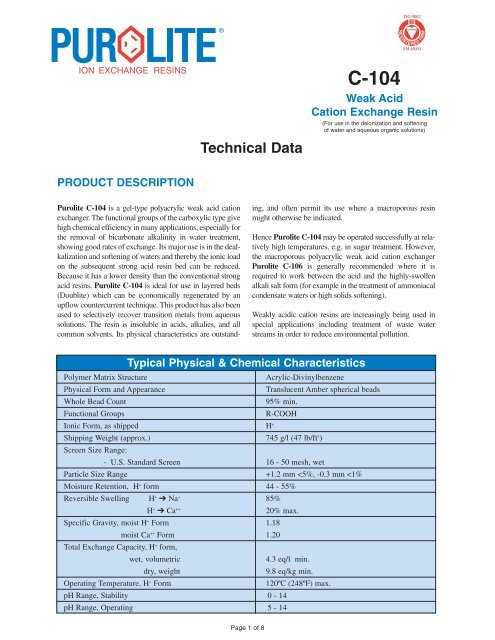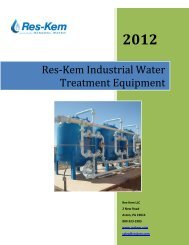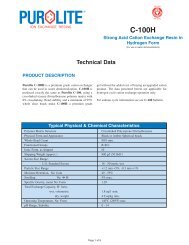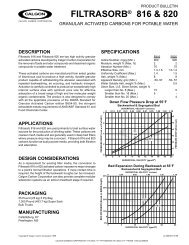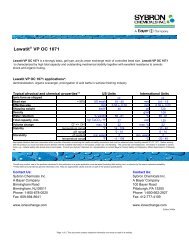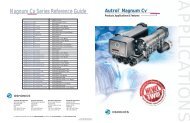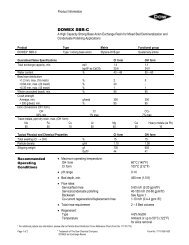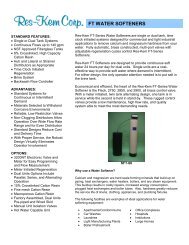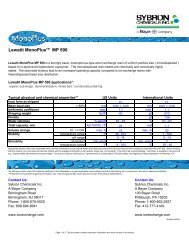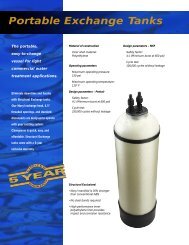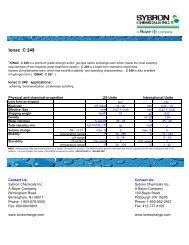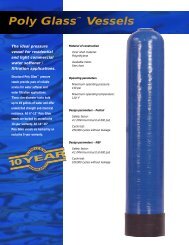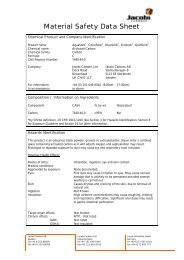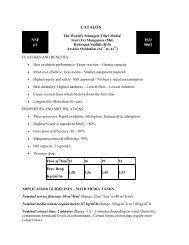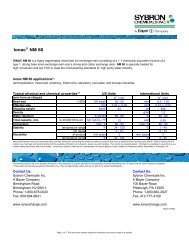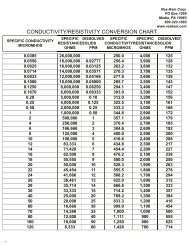Technical Data Sheet - Res-Kem Corporation
Technical Data Sheet - Res-Kem Corporation
Technical Data Sheet - Res-Kem Corporation
Create successful ePaper yourself
Turn your PDF publications into a flip-book with our unique Google optimized e-Paper software.
®<br />
ION EXCHANGE RESINS<br />
<strong>Technical</strong> <strong>Data</strong><br />
C-104<br />
Weak Acid<br />
Cation Exchange <strong>Res</strong>in<br />
(For use in the deionization and softening<br />
of water and aqueous organic solutions)<br />
PRODUCT DESCRIPTION<br />
Purolite C-104 is a gel-type polyacrylic weak acid cation<br />
exchanger. The functional groups of the carboxylic type give<br />
high chemical efficiency in many applications, especially for<br />
the removal of bicarbonate alkalinity in water treatment,<br />
showing good rates of exchange. Its major use is in the dealkalization<br />
and softening of waters and thereby the ionic load<br />
on the subsequent strong acid resin bed can be reduced.<br />
Because it has a lower density than the conventional strong<br />
acid resins, Purolite C-104 is ideal for use in layered beds<br />
(Doublite) which can be economically regenerated by an<br />
upflow countercurrent technique. This product has also been<br />
used to selectively recover transition metals from aqueous<br />
solutions. The resin is insoluble in acids, alkalies, and all<br />
common solvents. Its physical characteristics are outstanding,<br />
and often permit its use where a macroporous resin<br />
might otherwise be indicated.<br />
Hence Purolite C-104 may be operated successfully at relatively<br />
high temperatures, e.g. in sugar treatment. However,<br />
the macroporous polyacrylic weak acid cation exchanger<br />
Purolite C-106 is generally recommended where it is<br />
required to work between the acid and the highly-swollen<br />
alkali salt form (for example in the treatment of ammoniacal<br />
condensate waters or high solids softening).<br />
Weakly acidic cation resins are increasingly being used in<br />
special applications including treatment of waste water<br />
streams in order to reduce environmental pollution.<br />
Typical Physical & Chemical Characteristics<br />
Polymer Matrix Structure<br />
Acrylic-Divinylbenzene<br />
Physical Form and Appearance<br />
Translucent Amber spherical beads<br />
Whole Bead Count<br />
95% min.<br />
Functional Groups<br />
R-COOH<br />
Ionic Form, as shipped H +<br />
Shipping Weight (approx.) 745 g/l (47 lb/ft 3 )<br />
Screen Size Range:<br />
- U.S. Standard Screen 16 - 50 mesh, wet<br />
Particle Size Range +1.2 mm
Standard Operating Conditions<br />
Operation Rate Solution Minutes Amount<br />
Service 8 - 40 BV/h Influent water per design per design<br />
1.0 - 5.0 gpm/ft 3<br />
Backwash Refer to Fig. 2 Influent water 5 - 20 2 - 8 BV<br />
20ºC (68ºF) 15 - 60 gal/ft 3<br />
Regeneration 4 - 8 BV/h 1 - 4% HCl 30 - 45 100 - 120% of<br />
0.5 - 1 gpm/ft 3 theory<br />
8 - 20 BV/h 0.5 - 1% H 2 SO 4<br />
1 - 2.5 gpm/ft 3<br />
Rinse, (slow) same as Water (influent or 15 approx. 2 - 4 BV<br />
regeneration decationized) 15 - 30 gal/ft 3<br />
Rinse, (fast) 10 - 40 BV/h Water (influent or 3 - 6 BV<br />
1.25 - 5.0 gpm/ft 3 decationized) 22 - 45 gal/ft 3<br />
Backwash Expansion 50% to 75%<br />
Design Rising Space 100%<br />
Minimum bed depth 700 mm (30 inches)<br />
"Gallons" refer to U.S. Gallon = 3.785 liters<br />
REGENERATION<br />
When Purolite C-104 is exhausted with a high amount<br />
of hardness, it is best regenerated with hydrochloric acid<br />
to avoid precipitation. However, due to availability and<br />
cost, this may not be convenient, and sulphuric acid can<br />
be used. Operating capacity and treated water quality are<br />
essentially unaffected provided that the regenerant concentration<br />
is kept below 0.8%. Alternatively, stepwise<br />
regeneration can be used. This will reduce regenerant<br />
volumes and consequently slightly reduce the acid consumed<br />
in neutralizing the alkalinity in the water used for<br />
regeneration. The maximum concentration of sulphuric<br />
acid recommended for stepwise regeneration procedures<br />
is 1.5%. The higher concentration should be used for the<br />
second half of the regenerant quantity. Concentrations<br />
higher than 1.5% can only be used when the hardness<br />
(particularly calcium) loading is low.<br />
HYDRAULIC CHARACTERISTICS<br />
The pressure drop (or headloss) across a properly classified<br />
bed of ion exchange resin depends on the particle<br />
size distribution, bed depth, and voids volume of the<br />
exchange material, as well as on the flowrate and viscosity<br />
(and hence on the temperature) of the influent<br />
solution. Factors affecting any of these parameters, for<br />
example the presence of particulate matter filtered out by<br />
the bed, abnormal compressibility of the resin, or the<br />
incomplete classification of the bed, will have an<br />
adverse effect, and result in an increased headloss.<br />
Depending on the quality of the influent water, the application<br />
and the design of the plant, service flow rates may<br />
vary from 10 - 40 bed volumes/hour (1-5 gpm/ft 3 ).<br />
Typical pressure drop data is given in Fig. 1.<br />
Page 2 of 8
PRESSURE DROP, kg/cm 2 /m<br />
Fig. 1 PRESSURE DROP VS FLOW RATE<br />
1.0<br />
0.8<br />
0.6<br />
0.4<br />
0.2<br />
FLOW RATE, U.S. gpm/ft 2<br />
8 16 24<br />
10°C (50°F)<br />
20°C (68°F)<br />
30°C (86°F)<br />
40°C (104°F)<br />
4<br />
3<br />
2<br />
1<br />
PRESSURE DROP, psi/ft of bed depth<br />
BED EXPANSION, Percent<br />
100<br />
50<br />
Fig. 2 BACKWASH EXPANSION<br />
Ca/Mg EXHAUSTED FORM<br />
FLOW RATE, U.S. gpm/ft 2<br />
2 4 6 8<br />
5°C (40°F)<br />
15°C (60°F)<br />
30°C (86°F)<br />
0 20 40 60<br />
FLOW RATE, m/h<br />
0 5 10 15 20<br />
FLOW RATE, m/h<br />
During upflow backwash, the resin bed should be<br />
expanded in volume by between 50 and 70%. This operation<br />
will free it from any particulate matter, clear the<br />
bed of bubbles and voids, and reclassify the resin particles,<br />
ensuring minimum resistance to flow. Bed expansion<br />
increases with flow rate and decreases with<br />
temperature, as shown in Fig. 2. for the exhausted<br />
(Ca ++ /Mg ++ ) form of the resin. Bed expansion of the resin<br />
in the H + form is generally higher by about 10 - 15% for<br />
a given flowrate, but a 50% increase in flowrate is<br />
required for a similar bed expansion in the more highly<br />
swollen Na + form of Purolite C-104. Care should always<br />
be taken to avoid resin loss by over-expansion of the bed.<br />
Conversion of Units<br />
1 m/h (cubic meters per square meter per hour) = 0.341 gpm/ft 2<br />
= 0.409 U.S. gpm/ft 2<br />
1 kg/cm 2 /m (kilograms per square cm = 4.33 psi/ft<br />
per meter of bed)<br />
= 1.03 atmos/m<br />
= 10 ft H 2 O/ft<br />
PROPERTIES OF WEAKLY ACIDIC CATION RESINS<br />
The behavior of weakly acidic cation resins is<br />
markedly different from strongly acidic cation resins<br />
which show essentially the same capacity for the<br />
uptake of cations over a wide pH range. The amounts<br />
of acid required to regenerate the latter to the hydrogen<br />
form are considerable, especially when they are<br />
loaded with multivalent ions, which are often preferentially<br />
held. In contrast, carboxylic groups are<br />
almost completely nonionized in mildly acidic or<br />
neutral conditions. In pure water, a commercial<br />
monofunctional carboxylic resin such as Purolite<br />
C-104 will have less than one in a hundred<br />
of its carboxylic groups ionized to give a hydrated<br />
hydrogen ion. Thus while it will show under<br />
appropriate conditions very high selectivity for<br />
multivalent ions, and indeed acts as a chelating<br />
Page 3 of 8
esin for certain of them, e.g. Fe +++ , UO 2<br />
++<br />
, or<br />
Cu ++ , it can readily be regenerated with near stoichiometric<br />
amounts of acid, providing a concentrated<br />
regenerant effluent as a result of excellent chemical<br />
efficiency.<br />
The analogous weak base resins have found widespread<br />
application in the removal of organic acids<br />
from sugar solutions, and in water treament for the<br />
removal of mineral acids from the first (cation) stage<br />
of two-bed demineralization. Consequently, their use<br />
in lessening the load on the following strong base<br />
anion exchange bed, and thereby enabling higher<br />
quality water to be obtained without an increase in<br />
regenerant level, is well understood. Not so well<br />
understood, perhaps, is the corresponding use of the<br />
weak acid resins to lighten the load on the strong acid<br />
resin columns in multi-bed systems; although many<br />
raw waters for public water supplies contain appreciable<br />
amounts of multivalent ions, often in conjunction<br />
with bicarbonate alkalinity.<br />
In the hydrogen form Purolite C-104 eliminates all the<br />
hardness ions(M) associated with bicarbonate alkalinity<br />
by the reaction:<br />
2 R COOH + M (HCO 3 ) 2 → R COO M OOC R +<br />
2 H 2 O + 2 CO 2<br />
The aqueous carbon dioxide provides an acid of a<br />
strength significant compared to that of the resin, thus<br />
preventing the reaction from going to completion, as in<br />
the normal neutralization of bicarbonates. The net result<br />
is that hardness ions associated with mineral acids are<br />
not removed from the solution.<br />
In the sodium form, there is a higher selectivity for (e.g.)<br />
calcium than is shown by the strong acid cation exchangers:<br />
2 R COONa + CaCl 2 → R COO Ca OOC R +<br />
2 NaCl<br />
Regeneration of the exhausted form is virtually<br />
stoichiometric:<br />
R COO M OOC R + 2 HCl → 2 R COOH + MCl 2<br />
APPLICATIONS<br />
Purolite C-104E is a specially prepared weak acid<br />
cation resin which has been purified to meet the taste and<br />
odor requirements for food and potable water applications.<br />
These resins can be so used with the minimum<br />
amount of pretreatment after a period of storage, and<br />
with no additional treatments during the operational life,<br />
provided the resins are in continuous use. However, it<br />
should be pointed out that, for reasons of health and<br />
safety, it is not permissible to render toxic water supplies<br />
potable by treatments which exceed the recommendations<br />
of the FDA or FIRA. Care should be taken to<br />
ensure that high quality regenerants are always used.<br />
Exposure to strong oxidizing agents causes irreversible<br />
damage. Levels should be kept to a<br />
minimum.<br />
When intermittently used, the resins should be<br />
stored in the fully regenerated form under<br />
water.<br />
Special grades of Purolite C-104 are also available for<br />
various applications. These special grades include<br />
Purolite C-104DL, for use in layered beds (Doublite<br />
systems). Purolite C-104DL is positioned above<br />
Purolite C-100DL or Purolite C-100X10DL. The system<br />
is used to optimize the hardness removal of an influent<br />
stream containing a high amount of bicarbonate<br />
alkalinity. The most efficient version uses counter current<br />
regeneration with dilute acid. Alternatively, a centre<br />
collector allows for separate regeneration of the two layers.<br />
Purolite DL systems are specially graded to optimize<br />
separation during backwash. Purolite C-104S is<br />
recommended for use in deionization of sugar solutions,<br />
and Purolite C-104C is recommended for high flow rate<br />
applications.<br />
Standard grades are generally used for either softening or<br />
demineralization of water in a number of different ways.<br />
These are described in more detail under “operating<br />
capacity” as follows:<br />
OPERATING CAPACITY<br />
In the field of water treatment, the operating capacity of<br />
a unit containing a carboxylic resin is a function of a<br />
number of variables. Their significance depends on<br />
which mode of operation is to be used. The different<br />
modes to be considered are conveniently described as:<br />
a) dealkalization<br />
b) partial decationization<br />
c) acid cycle softening<br />
d) sodium cycle softening<br />
The first and most important set of variables is related to<br />
the influent solution and the conditions under which it is<br />
being treated. The ionic composition (and particularly<br />
the pH), temperature, and flowrate are all independent<br />
variables.<br />
The composition is usually expressed in terms of total<br />
hardness (TH) and temporary hardness, otherwise<br />
known as “bicarbonate alkalinity”, together with the<br />
“equivalent mineral acidity” (EMA), which is in fact that<br />
portion of the total cations associated with the anions of<br />
Page 4 of 8
strong “mineral” acids. The total “alkalinity”, (ALK), of<br />
an influent water is yet another parameter, in this case<br />
the portion of the total cations associated with hydroxide<br />
and carbonate, as well as the bicarbonate anions. In the<br />
dealkalization mode, operating capacity is usually taken<br />
to a fixed breakthrough of typically 10% of influent alkalinity.<br />
Reference to Fig. 3 shows that the operating capacity(Q)<br />
for removal of metal ions associated with alkalinity,<br />
(mode (a) above), is highly dependent upon the ratio of<br />
total hardness to alkalinity (). This dependence arises<br />
because the selectivity of weakly acidic cation resins for<br />
hardness ions is high compared to that for monovalent<br />
cations, a property which affects the nature of the chromatographic<br />
front (i.e. whether self-sharpening or diffuse)<br />
in any column absorption or separation process.<br />
The ratio determines whether the bicarbonate front<br />
moving down the column is associated with alkali metal<br />
cations, or alkaline earth metal cations (sodium or calcium/magnesium<br />
in normal raw waters). The latter give<br />
a much sharper front, since the equilibrium is more<br />
favorable. The ratio, , is thus a parameter of significance,<br />
(as can be seen from Fig. 3).<br />
It is worth noting that values around unity will tend to<br />
result in irreproducible operating capacities, arising from<br />
quite small fluctuations in influent composition.<br />
However, the use of the recommended regeneration level<br />
of 105% of the average operating capacity as standard is<br />
self-adjusting, because of the higher efficiency of both<br />
regeneration and loading profiles in the resin. Correction<br />
factors for the effect of temperature of the influent and<br />
for the effect of flow rate are given in Figs. 4 and 5<br />
respectively.<br />
Hence actual operating capacity is given by multiplying<br />
the capacity obtained in Fig. 3 by factors C 1 and C 2 from<br />
Figs. 4 and 5 in turn. The usual engineering design factor<br />
of 0.9 should also be applied.<br />
REGENERANT QUANTITY<br />
If Q is the operating capacity in eq/l, the amount of HCl<br />
needed to regenerate will be 38.3 Q grams of 100% HCl<br />
per liter of resin the amount of H 2 SO 4 needed to regenerate<br />
will be 55.38 Q grams of 93% H 2 SO 4 per liter of resin.<br />
If Q is the operating capacity in Kgr/ft 3 the amount of HCl<br />
needed will be 0.1092 Q Lbs of 100% HCl per cubic foot<br />
or 0.1572 Q Lbs of 93% H 2 SO 4 per cubic foot of resin.<br />
When sulphuric acid is used, the lower concentrations<br />
and more rapid flow rates are recommended to prevent<br />
precipitation of calcium sulphate in the resin bed. For the<br />
same resin, the recommended regeneration flow rates<br />
should be used. The resin bed should not be allowed to<br />
stand in a part-regenerated form in the presence of the<br />
regenerant sulphuric acid. If nitric acid is being considered<br />
for regeneration then please contact the technical<br />
group at Purolite.<br />
It should be noted that higher capacities may be obtained<br />
depending upon the level of leakage of cations which is<br />
acceptable in the treated solution. This partial decationization<br />
(mode (b) above) can give operating capacities<br />
up to 20% higher than those given for standard dealkalization.<br />
It follows that alkalinity leakage will accompany<br />
the excess cation leakage.<br />
Where softening of the influent is the objective, the use<br />
of weak acid cation resins should be considered as an<br />
alternative to conventional softening. It has the advantage<br />
that the total dissolved solids will be reduced at least<br />
by the level of temporary hardness in the influent. This<br />
can produce a treated water more suitable for certain<br />
cleaning and washing processes than that obtained from<br />
traditional softening. Where the ratio is less than unity,<br />
Purolite C-104 will remove hardness to a low level and<br />
produce water with a pH between 3.5 - 8 when regenerated<br />
with acid as described above. The operating capacity<br />
obtainable is 3 eq/1 (independent of , but<br />
temperature and flow rate corrections still apply). This<br />
application is termed acid cycle softening, (mode (c)<br />
above). Where is more than unity only partial softening<br />
(temporary hardness removal) is obtained. In order to<br />
obtain permanent hardness removal, standard softening<br />
using the Purolite C-100 series of products should follow<br />
the acid cycle softening. Operating capacity is identical<br />
to that for dealkalization and standard softening<br />
respectively.<br />
Alternatively, complete hardness removal can be<br />
achieved by means of a single bed of weak acid cation<br />
resin by using a two step regeneration process. The<br />
exhausted resin is first regenerated with relatively high<br />
levels of acid (150 g/l, 9 lbs/ft 3 ), and this is followed by<br />
sodium carbonate (160 g/l, 10 lbs/ft 3 ), (mode (d) above).<br />
Softening in the sodium cycle requires that the<br />
acid-regenerated form is converted directly to the working<br />
sodium form. Since Purolite C-104 has an expansion<br />
of around 90% when converted from the hydrogen form<br />
to the sodium form, the resin is not specifically recommended<br />
for use in this mode. Purolite C-106 is the resin<br />
of choice especially for high solids softening (Expansion<br />
only 60%).<br />
Page 5 of 8
Fig. 3 OPERATING CAPACITY VS TH/ALK RATIO, <br />
AT 20°C, FLOWRATE 15BV/h, INFLUENT ALK = 4 meq/l<br />
4.0<br />
Fig. 4 TEMPERATURE CORRECTION FACTOR<br />
TEMPERATURE °F<br />
50 68 86<br />
OPERATING CAPACITY eq/l<br />
3.0<br />
2.0<br />
1.0<br />
70<br />
60<br />
50<br />
40<br />
30<br />
20<br />
10<br />
OPERATING CAPACITY Kg/ft 3<br />
CORRECTION FACTOR C 1<br />
1.1<br />
1.0<br />
0.9<br />
0.8<br />
0<br />
0 0.5 1 1.5 2<br />
RATIO <br />
TOTAL HARDNESS<br />
( )<br />
TOTAL ALKALINITY<br />
0 10 20 30<br />
TEMPERATURE °C<br />
Fig. 5 FLOWRATE CORRECTION FACTOR<br />
U.S. gpm/ft 3<br />
1 2 3 4 5<br />
CORRECTION FACTOR C 2<br />
1.25<br />
1.0<br />
0.75<br />
0.5<br />
0 10 20 30 40<br />
BV/h<br />
Page 6 of 8
NOTES<br />
Page 7 of 8
ION EXCHANGE RESINS<br />
®<br />
WORLDWIDE OFFICES<br />
USA: www.puroliteUSA.com<br />
International: www.purolite.com<br />
U.S.A.<br />
The Purolite Company<br />
150 Monument Road<br />
Bala Cynwyd, PA 19004<br />
Phone: (1) 610-668-9090<br />
Toll Free: 800-343-1500<br />
Telefax: (1) 610-668-8139<br />
Email: sales@puroliteUSA.com<br />
TEXAS<br />
The Purolite Company<br />
1700 West Loop South<br />
Suite 740<br />
Houston, TX 77027<br />
Toll Free: 800-562-6488<br />
Telefax: (1) 713-627-7890<br />
CANADA<br />
The Purolite Company<br />
625 Wabanaki Drive<br />
Unit #2<br />
Kitchener, Ontario N2C 2G3<br />
Toll Free: 800-461 -1500<br />
or (1) 519-896-6674<br />
Telefax: (1) 519-896-6679<br />
UNITED KINGDOM<br />
Purolite International Limited<br />
Kershaw House<br />
Great West Road<br />
Junction with Lampton Road<br />
Hounslow, TW5 OBU<br />
Sales Phone: (44) 181 -570-4454<br />
Telefax: (44) 181-572-7726<br />
European Marketing<br />
Phone: (44) 181-577-1222<br />
Telefax (44) 181-577-1136<br />
GERMANY<br />
Purolite Deutschland GmbH<br />
Harkort Strasse 25<br />
40880 Ratingen<br />
Phone: (49) 2102-46033<br />
Telefax: (49) 2102-443663<br />
FRANCE<br />
Purolite International SARL<br />
34 Avenue Matignon<br />
75008 Paris<br />
Phone: (33) 1-4256-4563<br />
Telex: 648856<br />
Telefax: (33) 1-4563-3826<br />
SPAIN<br />
Purolite Iberica S.A.<br />
Parc Tecnologic del Valles<br />
Centre Empreses Noves Tecnologies<br />
08290 Cerdanyola del Valles (Barcelona)<br />
Phone: (34) 3-582-0266<br />
Telefax: (34) 3-582-0268<br />
EGYPT<br />
Purolite International Middle East<br />
Cairo Liaison Office<br />
12 Obour Gardens<br />
Fifth Floor, App. No. 55<br />
Salah Salem Street<br />
Nasr City, Cairo<br />
Phone: (20) 2-4021477<br />
Telefax: (20) 2-4021478<br />
ITALY<br />
Purolite International S.r.l.<br />
Viale Coni Zugna 29<br />
20144 Milan<br />
Phone: (39) 02-481-8145<br />
Telefax: (39) 02-4801-2359<br />
ROMANIA<br />
Purolite Romania<br />
International Business Center Modern<br />
B-dul Carol I No. 34-36<br />
5th Floor<br />
Bucharest, Sector 2<br />
Phone: (40) 1-250-5053/5028<br />
Telefax: (40) 1-250-5999<br />
POLAND<br />
Head Office<br />
Radus Spolka z o.o.<br />
ul Przebendowskich 33<br />
81-543 Gdynia<br />
Phone/Fax (48) 58-6248118<br />
GLIWICE<br />
Radus Spolka z o.o.<br />
ul Górnych Walów 25<br />
44-100 Gliwice<br />
Phone: (48) 32-315-931<br />
Telefax: (48) 32-315-931<br />
SLASK<br />
Radus Spolka z o.o.<br />
ul 3 Maja 3/33<br />
32-600 Oswiecim<br />
Phone: (48) 33-425-603<br />
Telefax: (48) 33-425-603<br />
CZECH & SLOVAK REPUBLICS<br />
Purolite International<br />
Nad Mazankou 17<br />
182 00 Prague 8<br />
Phone: (420) 2-688-1086<br />
Telefax: (420) 2-688-1086<br />
RUSSIA<br />
Head Office<br />
Purolite International<br />
10th Floor<br />
36 Lyusinovskaya Street<br />
Moscow<br />
Phone: (7) 095-564-8120<br />
Telefax: (7) 095-564-8121<br />
ST. PETERSBURG<br />
Purolite International Limited<br />
12 Building A Tambovskaya St.<br />
St. Petersburg<br />
192007 Russian Federation<br />
Phone: (7) 812-327-8530<br />
Telefax: (7) 812-327-9079<br />
KAZAKHSTAN<br />
Purolite RH Limited<br />
Office 205<br />
240 Dostyk AV.<br />
Almaty 480051<br />
Phone: (7) 3272-641-234<br />
Telefax: (7) 3272-641-234<br />
SINGAPORE<br />
Purolite International (Singapore)<br />
PTE Limited<br />
32-04 The Concourse<br />
300 Beach Road, 199555<br />
Phone: (65) 297-0889<br />
297-1453<br />
Telefax: (65) 297-1986<br />
CHINA<br />
Head office<br />
Purolite (China) Company, Ltd.<br />
Chengguan Town<br />
Deqing County<br />
Zhejiang Province 313200<br />
Phone: (86) 572-842-2908<br />
Telefax: (86) 572-842-3954<br />
TAIWAN<br />
Purolite International<br />
16F-2, No. 191<br />
Fu-hsing N. Road,Taipei<br />
Phone: (886) 2-546-7078<br />
Telefax: (886) 2-546-7069<br />
MEXICO<br />
Purolite International, S.A. De C.V.<br />
World Trade Center<br />
Montecito 38, Piso 33,Oficina-19<br />
Mexico D.F. 03810<br />
Phone: (52) 5-488-0904<br />
Telefax: (52) 5-488-0906<br />
UKRAINE<br />
Purolite International Limited<br />
2 Korolenko Street.<br />
Dnepropetrovsk 320070<br />
Phone: (38) 0562-320-065<br />
0562-320-066<br />
Telefax: (38) 0562-320-067<br />
KOREA<br />
Purolite International (Korea) LLC<br />
Dae Yeon Bldg., Suite 403<br />
943-30 Daechi-dong<br />
Kangnam-gu, Seoul<br />
Phone: (82) 2-3453-7062/7063<br />
Telefax: (82) 2-3453-7064<br />
All suggestions and recommendations given above concerning the use of Purolite products are based on tests and data believed to be reliable. However, as Purolite cannot<br />
control the use of its products by others, no guarantee is either expressed or implied by any such suggestion or recommendation by Purolite nor is any information contained<br />
in this leaflet to be construed as a recommendation to infringe any patent currently valid.<br />
C-104/1299/SOP


